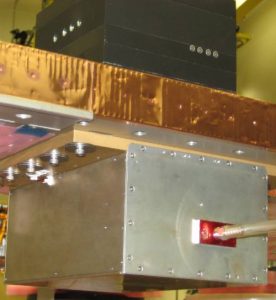
NMS mounted on the e-POP deck on CASSIOPE
The e-POP Neutral Mass and velocity Spectrometer (NMS) was designed to measure the mass composition and velocity of neutral atmospheric species in the 1-40 amu mass and 0.1-2 km/s velocity range.
NMS uses an open-source electron impact ionization chamber and a microchannel plate (MCP) imaging detection subassembly. It employs a planar entrance aperture with a plasma filter to repel low energy charged particles. The rammed neutrals enter the aperture and traverse through an electron source. The ionized population is then accelerated into the instrument by a potential difference between the entrance aperture and the detection subassembly. Ions arriving at the annular microchannel plate detector are sorted according to their arrival angle (azimuthal location) and energy (radial location). Thus, the instrument is capable of resolving both the neutral particle composition and the flow velocity.
Data from NMS on-orbit operations has been found to differ significantly from the data collected during ground calibration operations. As such, no level 1+ data products from NMS have been produced for public use.
NMS development was spearheaded by the Japan Aerospace Exploration Agency, with Dr. Hajime Hayakawa as principal investigator. MEISEI was the prime build contractor.
